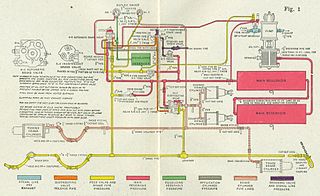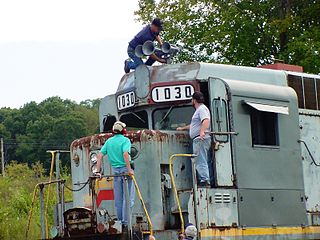
A railway air brake is a railway brake power braking system with compressed air as the operating medium. Modern trains rely upon a fail-safe air brake system that is based upon a design patented by George Westinghouse on April 13, 1869. The Westinghouse Air Brake Company was subsequently organized to manufacture and sell Westinghouse's invention. In various forms, it has been nearly universally adopted.

A conductor or guard is a train crew member responsible for operational and safety duties that do not involve actual operation of the train/locomotive. The conductor title is most common in North American railway operations, but the role is common worldwide under various job titles. In Commonwealth English, a conductor is also known as guard or train manager.

A caboose is a crewed North American railroad car coupled at the end of a freight train. Cabooses provide shelter for crew at the end of a train, who were formerly required in switching and shunting, keeping a lookout for load shifting, damage to equipment and cargo, and overheating axles.

Brake van and guard's van are terms used mainly in the UK, Ireland, Australia and India for a railway vehicle equipped with a hand brake which can be applied by the guard. The equivalent North American term is caboose, but a British brake van and a caboose are very different in appearance, because the former usually has only four wheels, while the latter usually has bogies. German railways employed brakeman's cabins combined into other cars.
Rail transport terms are a form of technical terminology applied to railways. Although many terms are uniform across different nations and companies, they are by no means universal, with differences often originating from parallel development of rail transport systems in different parts of the world, and in the national origins of the engineers and managers who built the inaugural rail infrastructure. An example is the term railroad, used in North America, and railway, generally used in English-speaking countries outside North America and by the International Union of Railways. In English-speaking countries outside the United Kingdom, a mixture of US and UK terms may exist.

On trains, the expression emergency brake has several meanings:
A RoadRailer is a trailer or semi-trailer that can be hauled on roads by a tractor unit and then by way of a fifth wheel coupling, operate in a unit train on railway lines. The RoadRailer system allows trailers to be pulled by locomotives without the use of flatcars, instead attaching trailers directly to bogies.
On 8 February 1986, twenty-three people were killed in a collision between a Canadian National Railway freight train and a Via Rail passenger train called the Super Continental, including the engine crews of both trains. It was the deadliest rail disaster in Canada since the Dugald accident of 1947, which had thirty-one fatalities, and was not surpassed until the Lac-Mégantic rail disaster in 2013, which resulted in 47 deaths.

A bank engine, banking engine, helper engine or pusher engine is a railway locomotive that temporarily assists a train that requires additional power or traction to climb a gradient. Helpers/bankers are most commonly found in mountain divisions, where the ruling grade may demand the use of substantially greater motive power than that required for other grades within the division.

On January 4, 1987, two trains collided on Amtrak's Northeast Corridor main line near Chase, Maryland, United States, at Gunpow Interlocking. Amtrak train 94, the Colonial, traveling north from Washington, D.C., to Boston, crashed at over 100 miles per hour (160 km/h) into a set of Conrail locomotives running light which had fouled the mainline. Fourteen passengers on the Amtrak train died, as well as the Amtrak engineer and lounge car attendant.

The Utah Railway is a class III railroad operating in Utah and Colorado, and owned by Genesee & Wyoming Inc.

Emergency vehicle equipment is any equipment fitted to, or carried by, an emergency vehicle, other than the equipment that a standard non-emergency vehicle is fitted with.

A brakeman is a rail transport worker whose original job was to assist the braking of a train by applying brakes on individual wagons. The advent of through brakes, brakes on every wagon which could be controlled by the driver, made this role redundant, although the name lives on, for example, in the United States where brakemen carry out a variety of functions both on the track and within trains.

In road vehicles, the parking brake, also known as a handbrake or emergency brake (e-brake), is a mechanism used to keep the vehicle securely motionless when parked. Parking brakes often consist of a pulling mechanism attached to a cable which is connected to two wheel brakes. In most vehicles, the parking brake operates only on the rear wheels, which have reduced traction while braking. The mechanism may be a hand-operated lever, a straight pull handle located near the steering column, or a foot-operated pedal located with the other pedals.
This article contains a list of terms, jargon, and slang used to varying degrees by railfans and railroad employees in the United States and Canada. Although not exhaustive, many of the entries in this list appear from time to time in specialist, rail-related publications. Inclusion of a term in this list does not necessarily imply its universal adoption by all railfans and railroad employees, and there may be significant regional variation in usage.

The San Bernardino train disaster, was a combination of two separate but related incidents that occurred in San Bernardino, California, United States: a runaway train derailment on May 12, 1989; and the subsequent failure on May 25, 1989, of the Calnev Pipeline, a petroleum pipeline adjacent to the tracks which was damaged by earth-moving equipment during the crash cleanup.

A train horn is an air horn used as an audible warning device on diesel and electric-powered trains. Its primary purpose is to alert persons and animals to an oncoming train, especially when approaching a level crossing. They are often extremely loud, allowing them to be heard from great distances. They are also used for acknowledging signals given by railroad employees, such as during switching operations. For steam locomotives, the equivalent device is a train whistle.

North American railroad signals generally fall into the category of multi-headed electrically lit units displaying speed-based or weak route signaling. Signals may be of the searchlight, color light, position light, or color position light types, each displaying a variety of aspects which inform the locomotive operator of track conditions so that they may keep their train under control and able to stop short of any obstruction or dangerous condition.
An accident occurred on the four-track mainline of the New York Central Railroad at 10:02 P.M. on March 27, 1953, 2.4 miles east of Conneaut, Ohio. It began when an improperly secured load of pipe broke loose from a gondola car on an eastbound freight train, damaging the westbound passenger track. A passing westbound freight crew notified the first train and stopped to assess what had happened, but a fast westbound passenger train could not stop and was derailed by the damaged track, colliding with the adjacent westbound freight. Finally, an eastbound fast passenger train struck the derailed equipment from the first two trains. There were 21 deaths and 49 people were injured. This accident holds the record for the most trains involved in a single accident.

Trains include a variety of types of lights, for safety, illumination, and communicating train status. The most universal type of light is the headlight, which is included on the front of locomotives, and frequently on the rear as well. Other types of lights include classification lights, which indicate train direction and status, and ditch lights, which are a pair of lights positioned towards the bottom of a train to illuminate the tracks.




















